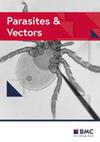Real-time PCR for malaria diagnosis and identification of Plasmodium species in febrile patients in Cubal, Angola
IF 3
2区 医学
Q1 PARASITOLOGY
引用次数: 0
Abstract
Malaria is the parasitic disease with the highest morbimortality worldwide. The World Health Organization (WHO) estimates that there were approximately 249 million cases in 2022, of which 3.4% were in Angola. Diagnosis is based on parasite identification by microscopy examination, antigen detection, and/or molecular tests, such as polymerase chain reaction (PCR). This study aimed to evaluate the usefulness of real-time PCR as a diagnostic method for malaria in an endemic area (Cubal, Angola). A cross-sectional study was carried out at the Hospital Nossa Senhora da Paz in Cubal, Angola, including 200 patients who consulted for febrile syndrome between May and July 2022. From each patient, a capillary blood sample was obtained by finger prick for malaria field diagnosis [microscopy and rapid diagnostic test (RDT)] and venous blood sample for real-time PCR performed at the Hospital Universitario Vall d’Hebron in Barcelona, Spain. Any participant with a positive result from at least one of these three methods was diagnosed with malaria. Of the 200 participants included, 54% were female and the median age was 7 years. Malaria was diagnosed by at least one of the three techniques (microscopy, RDT, and/or real-time PCR) in 58% of the participants, with RDT having the highest percentage of positivity (49%), followed by real-time PCR (39.5%) and microscopy (33.5%). Of the 61 discordant samples, 4 were only positive by microscopy, 13 by real-time PCR, and 26 by RDT. Plasmodium falciparum was the most frequent species detected (90.63%), followed by P. malariae (17.19%) and P. ovale (9.38%). Coinfections were detected in ten participants (15.63%): six (60%) were caused by P. falciparum and P. malariae, three (30%) by P. falciparum and P. ovale, and one (10%) triple infection with these three species. In addition, it was observed that P. falciparum and P. malariae coinfection significantly increased the parasite density of the latter. RDT was the technique with the highest positivity rate, followed by real-time PCR and microscopy. The results of the real-time PCR may have been underestimated due to suboptimal storage conditions during the transportation of the DNA eluates. However, real-time PCR techniques have an important role in the surveillance of circulating Plasmodium species, given the epidemiological importance of the increase in non-falciparum species in the country, and can provide an estimate of the intensity of infection.用实时 PCR 技术诊断疟疾并鉴定安哥拉库巴尔发热病人体内的疟原虫种类
疟疾是全世界死亡率最高的寄生虫病。世界卫生组织(WHO)估计,2022年约有2.49亿病例,其中3.4%发生在安哥拉。诊断的依据是通过显微镜检查、抗原检测和/或聚合酶链反应(PCR)等分子检测来识别寄生虫。本研究旨在评估实时聚合酶链反应作为疟疾流行地区(安哥拉库巴尔)疟疾诊断方法的实用性。这项横断面研究在安哥拉库巴尔的帕斯圣母医院(Hospital Nossa Senhora da Paz)进行,包括2022年5月至7月期间因发热综合征就诊的200名患者。每位患者的毛细血管血样均由西班牙巴塞罗那瓦尔德希布伦大学医院采集,用于疟疾现场诊断(显微镜检查和快速诊断检测(RDT))和静脉血样本的实时 PCR 检测。凡是在这三种方法中至少有一种方法检测结果呈阳性的参与者均被诊断为疟疾患者。在 200 名参与者中,54% 为女性,年龄中位数为 7 岁。58% 的参与者至少通过三种技术(显微镜检查、RDT 和/或实时 PCR)中的一种诊断出疟疾,其中 RDT 阳性率最高(49%),其次是实时 PCR(39.5%)和显微镜检查(33.5%)。在 61 份不一致的样本中,4 份仅显微镜检查呈阳性,13 份为实时 PCR 阳性,26 份为 RDT 阳性。恶性疟原虫是最常检测到的疟原虫种类(90.63%),其次是疟疾疟原虫(17.19%)和卵形疟原虫(9.38%)。在 10 名参与者(15.63%)中发现了合并感染:6 人(60%)由恶性疟原虫和疟疾疟原虫引起,3 人(30%)由恶性疟原虫和卵形疟原虫引起,1 人(10%)同时感染了这三种疟原虫。此外,还观察到恶性疟原虫和疟疾疟原虫混合感染会显著增加后者的寄生虫密度。RDT 是阳性率最高的技术,其次是实时 PCR 和显微镜检查。实时 PCR 的结果可能被低估了,原因是 DNA 洗脱液在运输过程中的储存条件不够理想。不过,考虑到该国非疟原虫种类增加在流行病学上的重要性,实时 PCR 技术在监测循环疟原虫种类方面具有重要作用,并可提供感染强度的估计值。
本文章由计算机程序翻译,如有差异,请以英文原文为准。
求助全文
约1分钟内获得全文
求助全文
来源期刊

Parasites & Vectors
医学-寄生虫学
CiteScore
6.30
自引率
9.40%
发文量
433
审稿时长
1.4 months
期刊介绍:
Parasites & Vectors is an open access, peer-reviewed online journal dealing with the biology of parasites, parasitic diseases, intermediate hosts, vectors and vector-borne pathogens. Manuscripts published in this journal will be available to all worldwide, with no barriers to access, immediately following acceptance. However, authors retain the copyright of their material and may use it, or distribute it, as they wish.
Manuscripts on all aspects of the basic and applied biology of parasites, intermediate hosts, vectors and vector-borne pathogens will be considered. In addition to the traditional and well-established areas of science in these fields, we also aim to provide a vehicle for publication of the rapidly developing resources and technology in parasite, intermediate host and vector genomics and their impacts on biological research. We are able to publish large datasets and extensive results, frequently associated with genomic and post-genomic technologies, which are not readily accommodated in traditional journals. Manuscripts addressing broader issues, for example economics, social sciences and global climate change in relation to parasites, vectors and disease control, are also welcomed.
 求助内容:
求助内容: 应助结果提醒方式:
应助结果提醒方式:


